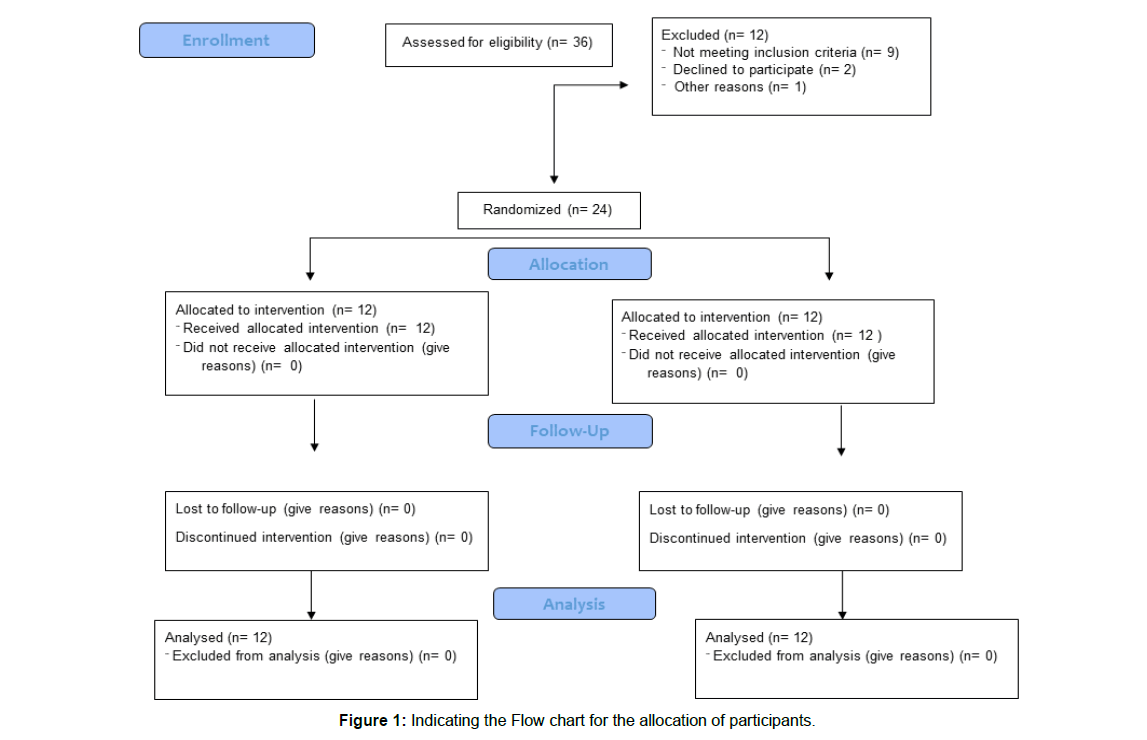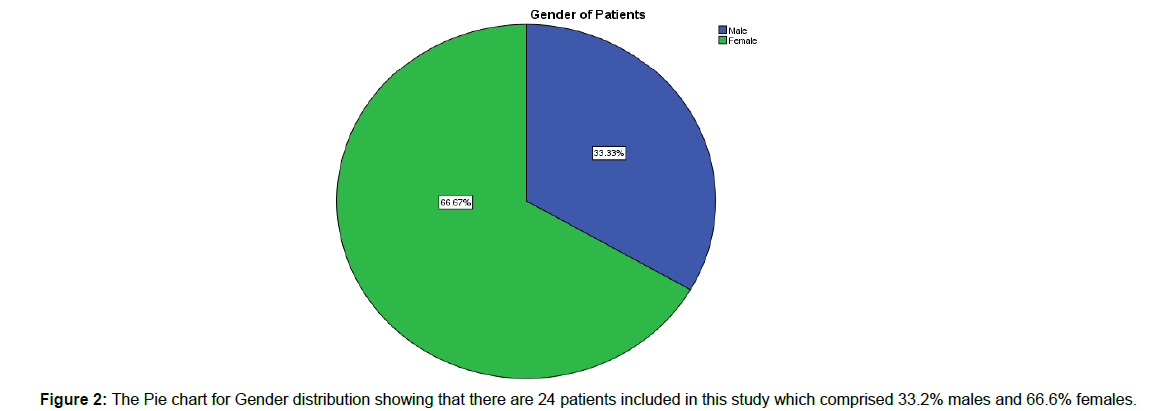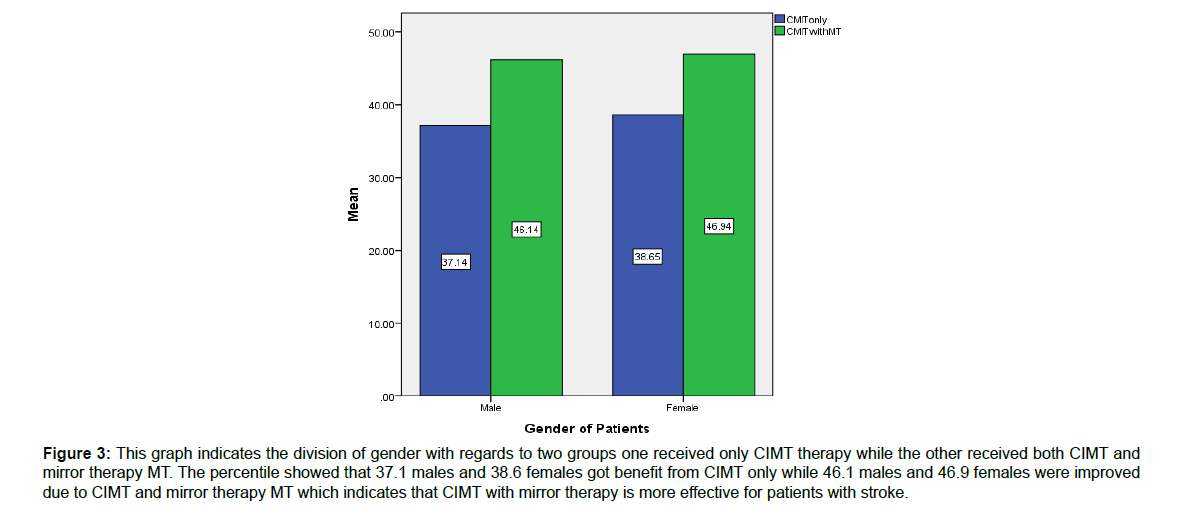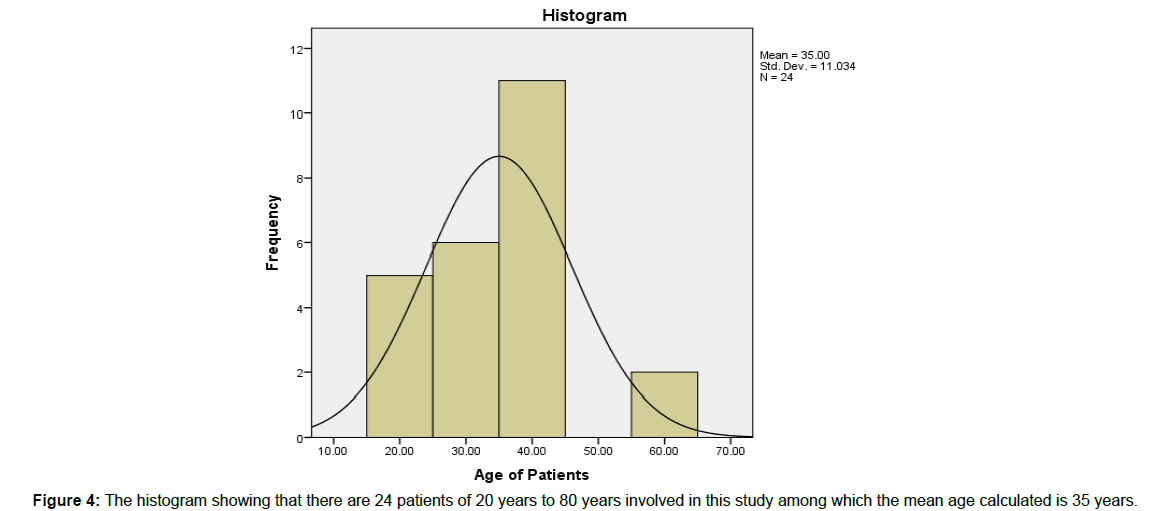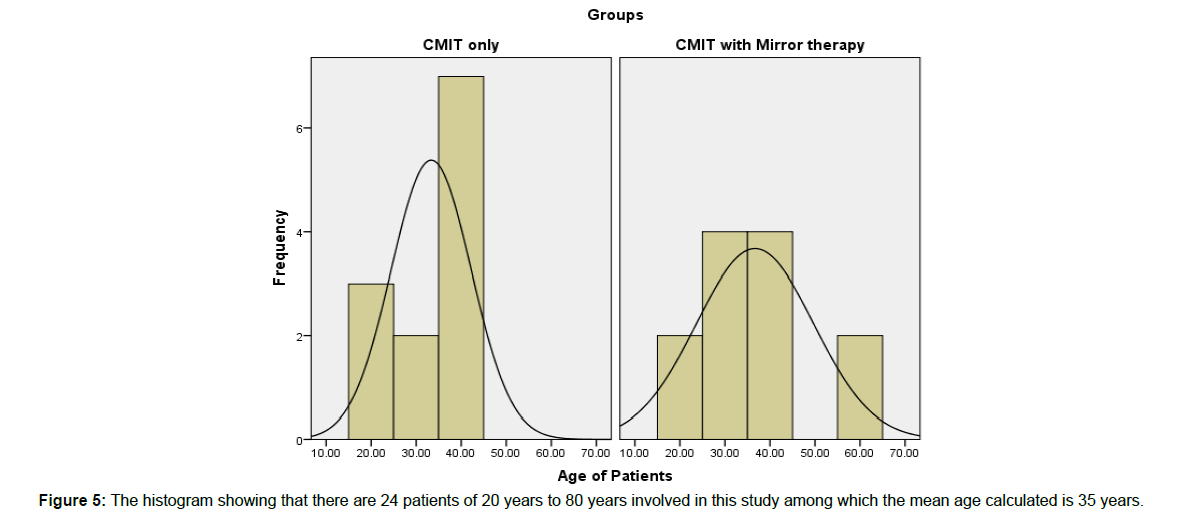Effectiveness of Constraint-Induced Movement Therapy combined with Mirror Therapy on Upper Motor Functions in Stroke Patients
Received: 15-Mar-2021 / Accepted Date: 23-Mar-2021 / Published Date: 30-Mar-2021 DOI: 10.4172/2165-7025.1000456
Abstract
Background: In all stroke survivors, 70-80% is suffered from motor functional disabilities. Constraint-induced movement therapy is an effective treatment method that has been used for the treatment of motor function in stroke patients. We have combined Constraint-induced movement therapy with another intervention Mirror therapy to assume better and quick results in improving motor function in stroke patients.
Methods and findings: Twenty-four patients with stroke were randomly divided into two groups: Constraint-induced movement therapy combined with mirror therapy group (n=12) and Constraint-induced movement therapy group (n=12). Both groups received interventions for a total of two weeks; (Constraint-induced movement therapy 6 hours per day and mirror therapy for 30 minutes per day) and were assessed by using the Korean version of the Modified Barthel Index scale. After two weeks of treatment, the Constraint-induced movement therapy combined with the mirror therapy group showed greater improvement than the Constraint-induced movement therapy group alone in improving upper motor function in patients with stroke (p<0.01).
Conclusion: Constraint-induced movement therapy combined with mirror therapy showed more improvement as compared to Constraint-induced movement therapy alone in the fine motor functions of patients with stroke.
Keywords: Constraint-induced movement therapy, Mirror therapy, Stroke
Abbreviation
CIMT: Constraint-Induced Movement Therapy; MT: Mirror Therapy
Introduction
Stroke is one of the major causes of disability in the world [1,2]. Concerning the clinical course, it is perceived that the patient may develop recovery of lower extremity earlier than the upper extremity [3]. Around 70-80% of the patients who survived the stroke develop motor function disabilities [4].
As, advances in the field of neurosciences [5,6] different new sorts of recovery treatments have been presented in the fields of neuroplasticity and brain mechanisms [7,8]. One of the recovery methods is reflected treatment, which depends on the idea of Ramachandran’s working on phantom limbs [8]. In mirror treatment, a hemiparetic person is requested to move the unaffected limb while watching the moving limb being reflected in the mirror. Mirror treatment has been connected to many stroke patients and has been found to encourage motor function recovery in randomized clinical studies [9]. Numerous examinations have also described biomechanical improvement and support the practical enhancement in exercises of everyday living (ADLs) after following mirror treatment [10,11]. Although there are different rehabilitation programs for stroke patients, CIMT is described as the use of the affected side more rather than the unaffected side to perform activities of daily livings in hemiplegic patients with stroke proposed by Taub et al. [12]. The patient wore an orthotic device in the less affected upper extremity for about fourteen days and in this way, not able to perform any activity, after which, the CIMT was performed on the hemiplegic upper extremity for six hours daily [13]. Also, a few studies proposed that these rehabilitation-assisted techniques were more helpful as compared with the palliative word-related treatments [14,15]. Moreover, in 1993, Taub et al. [12] announced that the CIMT was increasingly effective in enhancing the movement of the arm; however, its adequacy for the enhancement of hands function remained unclear [16]. Among the different rehabilitation programs, mirror therapy was first presented by Ramachandran in [17]. This treatment was more effective in treating phantom limb pain based on the idea of visual hallucinations by utilizing a mirror. It has been suggested that there were improvement in Fugl-Meyer Assessment and fine motor movement, following a 3-to 4-week course of mirror treatment in the patients with stroke [18].
Constraint-induced movement therapy, another kind of traditional rehabilitation treatment, was first created by Taub et al. in 1993 [8,19]. This method is based on using the affected arm and stops the movement of the unaffected side by a sling or support. Although there are different viewpoints related to CIMT, it has been received as the most effective rehabilitation method in recovering upper motor function in hemiplegic patients after stroke [20,21]. Numerous investigations have revealed that CIMT enhances upper extremity (UE) capacity and ADL functioning [12,3,22]. In this study, we have used CIMT on stroke patients. The unaffected side was supported by an external source to avoid its use, the methodology followed by Smania’s convention [12,21]. The principal difference between MT and CIMT is the use of the upper extremity. In mirror treatment, the unaffected arm is moved and the patient gets just visual hallucinations from the mirror. In CIMT, the unaffected arm is blocked by external support, and the affected arm is deliberately connected although the arm itself isn’t adequately moved. In both of the cases, the ultimate goal is based on the recovery in the function of the hemiplegic side. It is still not clear that both methods will help to restore motor movements in patients with stroke [3,16]. However, in the rehabilitation phase following a stroke, these treatments have been appeared to promote the recovery of motor movements. According to research, it has been shown that both mirror treatment and CIMT are effective treatment strategies in hemiplegic stroke patients [22]. Both CIMT and mirror treatment patients showed improvement in hemiplegic upper extremity (UE) movement and performing the activities of daily livings ADL [3,17,22]. To assess the viability of CIMT and mirror treatment for restoration of movement in patients with sub-acute stroke, Yoon in 2014 conducted a study. Twenty-six patients with sub-acute stroke were enlisted and divided into three groups: CIMT combined with mirror treatment group, CIMT only group, and control group. Following two weeks of treatment, both the CIMT with and without mirror treatment demonstrated higher enhancement (p<0.05) than the control group, in the improvement of motor function for the hemiplegic patients. Furthermore, a study by Helow, et al. (2015) used Modified constraintinduced movement therapy (m-CIMT) based on the use of the unaffected upper extremity to increase the dynamic movement of the hemiplegic arm for reestablishing the motor movement. The purpose was to see the effectiveness of m-CIMT on useful recovery of upper extremity (UE) function in stroke patients as compared with conventional rehabilitation therapy. Sixty stroke patients were included. The results showed a significant difference (p<0.05) between the two groups with m-CIMT showed as more effective method for restoring motor function. It is therefore a time of need to encourage the utilization of assisted treatment strategies in recovery of patients with post stroke rehabilitation. In the rehabilitation phase following a stroke, these treatments have been appeared to promote the recovery in the motor areas. Both mirror treatment and CIMT are found effective techniques in restoring the functional activity post stroke [23].Therefore the present study aimed to combine the both CIMT and MT treatments together to see their combined effectiveness on quick recovery response in restoring motor functioning in stroke patients.
Material And Methods
Study Design
It was a Qusai experimental Trial. The study was conducted in the Outpatient Department of Physical Therapy in a private hospital.
Sample size
A sample size of 24 stroke patients was taken in this study using 95% power of study and 5% level of significance. The non-probability purposive sampling technique was used to collect the data. The sample was divided into two groups; Constraint-Induced Movement Therapy and Mirror Therapy in stroke patients and Constraint-Induced Movement Therapy.
Inclusion and Exclusion Criteria
Patients were included:
• Patients with age >20 and <80
• Both male and female
• Patients who were hemiplegic due to stroke (onset time of more than six weeks)
• Patients who could maintain a sitting position for more than 30 minutes
• Patients who could make a simple communication
Following patients were excluded:
• Patients who were unable to cooperate in the treatment
• Those who were not able to perform active task training
• Those who had spasticity (Modified Ashworth Scale (MAS) II or higher)
• Patients who had other musculoskeletal problems (complex regional pain syndrome or secondary adhesive capsulitis)
• Neurological impairments
• Intellectual disabilities and Psychiatric disorders
Randomization & Binding
Subjects with hemiplegic stroke were recruited by physicians during a health education campaign. The participants who met the inclusion criteria were included in the study. All the participants signed written informed consent. Each participant was requested to draw either number one or number two from a box. Number one was allocated to Group A and number two was allocated to group B. Subjects were assessed 1 week after and before therapy. Before the exercise program, demographics and static, dynamic balance were assessed by a trained examiner.
Data Collection & Statistical Analysis
Modified Barthel Index Scale was used as an outcome measure tool. The data were expressed as mean ± standard deviation (SD); paired t-test was applied to test the hypothesis. A p-value of <0.05 was considered statistically significant (Figure 1).
Results
The present study was conducted to explore the effectiveness of CMIT and mirror therapy together or CMIT alone for upper motor function in stroke patients. Following results were obtained (Table 1).
| CIMT only | CIMT with Mirror Therapy | |||
|---|---|---|---|---|
| Mean ± SD | Mean ± SD | t(df) | P-value | |
| Stroke patients | 38.2 ± 5.17 | 46.7 ± 4.11 | -6.11(23) | 0.000 |
Table 1: Effectiveness of CIMT with mirror therapy technique and CIMT alone.
The results indicated that the patients treated by CIMT had the lower score and has less improvement (38.2 ± 5.17) as compared to the patients treated by CIMT with mirror therapy MT (46.7 ± 4.11) with P<0.01 The results revealed that CIMT with mirror therapy works well for stroke patients rather than CIMT alone (Table 2).
| Pre | Post | |||
|---|---|---|---|---|
| Mean ± SD | Mean ± SD | t(df) | P-value | |
| CMIT | 9.37 ± 5.8 | 28.8 ± 4.0 | -11.4(23) | 0.000 |
Table 2: Difference between Pre and Post-treatment in CIMT group.
The results showed a significant difference between pre and postscores of constraint-induced movement therapy. The results of the posttreatment CIMT group showed a higher score (M=28.8, S.D=4.0) as compared to the pretreatment in the CIMT group (M=9.37, S.D=5.8), P<0.05 indicates that CIMT is effective in improving motor function of stroke patients (Table 3).
| Pre | Post | |||
|---|---|---|---|---|
| Mean ± SD | Mean ± SD | t(df) | P-value | |
| CIMT and MT | 11.1 ± 2.6 | 35.5 ± 3.0 | -30.4(23) | 0.000 |
Table 3: Difference between pre and post-treatment in CIMT combined with MT group.
The results showed a highly significant difference between pre and post-scores of constraint-induced movement therapy with mirror therapy. The results of the post-treatment showed a higher score (M=35.5, S.D=3.0) as compared to the baseline (M=11.1, S.D=2.6), t(23)=0.000.P<0.01 indicates CIMT combined with MT is effective in improving motor function in stroke patients (Figure 2-5).
Figure 3: This graph indicates the division of gender with regards to two groups one received only CIMT therapy while the other received both CIMT and mirror therapy MT. The percentile showed that 37.1 males and 38.6 females got benefit from CIMT only while 46.1 males and 46.9 females were improved due to CIMT and mirror therapy MT which indicates that CIMT with mirror therapy is more effective for patients with stroke.
Discussion
The present study was conducted to identify that CIMT works well for stroke patients alone or there is a need to use it with a combination of other treatments. This study used MT along with CIMT to show its effectiveness in improving upper motor function in stroke patients. The results revealed that CIMT with mirror therapy is more effective for stroke patients as its work well and enhanced their work routine and improvement in their everyday life. While on the other hand, the researcher also examined both techniques’ effectiveness solely within the groups as pre and post-comparisons. The results revealed that patients in both groups at baseline have less performance while after receiving therapies both groups showed better performance. Gender difference also revealed a significant difference in the present study. The reason might be that they are more intense towards resting and feel pain only with hardship while females are more prone towards sensitivity. The present study was supported by previous literature; a study by (Yoon, et. al., 2014) revealed that the CIMT joined with mirror treatment indicated greater enhancement compared with CIMT only group and the control group, in the motor movements in upper extremity hemiplegic patients with sub-acute stroke.
However, on the other hand, a study by Yumi and Yoon; 2018 was conducted to decide whether the CIMT alone or CIMT combined with mirror therapy (MT) treatment impact the upper extremity capacity and whether the upper extremity work impacts the ability to perform activities of daily living and exercise. The two groups demonstrated an enhancement in upper extremity work, however, just the constraintinduced movement therapy demonstrated a relationship between upper extremity capacity and execution in the cleanliness, eating, and dressing. Our outcomes showed the patient’s ability to move the affected side and enhanced execution in exercises of everyday living and additional physical capacity.
Stroke is one of the major causes of disabilities [10]. The reduced muscle function and weakness after the stroke not only becomes a challenging situation for the patients, caretakers, and rehabilitation therapists but also delays the rehabilitation treatment [24,25]. The supposed phenomenon for the stroke patients with upper limb muscle weakness suggested using the affected side less than the unaffected side to perform functional tasks regularly [12,25]. This may lead the stroke patients to lose functional independence for the hemiplegic side while using the unaffected upper extremity. Previous literature suggested that if the short-term intensive rehabilitation treatments like CIMT and mirror therapy are conducted concurrently following symptoms in stroke patients they can be able to use the hemiplegic side more and more to perform daily activities and can eventually achieve functional [13]. These intensive rehabilitation treatments are based on structural plasticity and the gray and white matter changes after a stroke [14,15]. In association with structural changes in the gray matter following short-term intensive rehabilitation therapies such as the CIMT, it was shown that the contrast-induced movement therapy improved bilateral sensorimotor cortex increased by T1-weighted magnet resonance imaging scans for voxel-based morphometric. Also, previous studies have shown that there is a significant proportional correlation between the sizes of a bilateral sensorimotor cortex which is enhanced by contrast therapy, and the degree of functional recovery of the hemiplegic upper end [26]. The neurophysiologic mechanisms that are believed to underline treatment benefits of CIMT include overcoming learned nonuse and plastic brain reorganization. The brain changes itself when the affected extremity is involved intensively and repetitively for various activities. The effects of CIMT are explained as cortical reorganization dendrite branching, redundancy learned and synaptic strength.
The MT technique gives the patients visual illusion through visual feedback that the affected limb is moving. This method activates the premotor area, which has a role in enhancing motor recovery after stroke. Also, activating the premotor area can lead to enhancing the primary motor area and stimulating the motor function in the upper limb. Besides, MT may activate the right superior occipital gyrus and superior temporal gyrus. Previous work showed that the visual illusion through MT activates the mirror neurons that are found in the frontotemporal area, superior temporal gyrus, and sensorimotor cortex.
To explain the mechanisms of the mirror treatment, transcranial magnetic stimulation in normal healthy persons was carried out during the mirror illusion. The activity of the primary motor cortex (M1) corresponding to the contralateral hand on the mirror was shown to be increased [27]. The neurons are reported to be involved in the effects of the mirror therapy; they are bimodal vasomotor neurons and activated when action observation, psychological stimulation, and action are observed [28]. This results in additional CIMT and mirror therapy treatment effects based on different mechanisms. There are controversial opinions about the order and pattern of functional upper-end recovery. However, it is often noted that patients usually recover from near to distal extremity. The conventional CIMT improves the gross motor function effectively. However, its efficiency for minor engine functions has also been reported [7]. We performed the conventional CIMT concurrently with the mirror therapy in our medical center to improve the upper limb functions by focusing on fine motor training. It was determined that the fine motor functions give delayed recovery response by using CIMT alone. While the CIMT combined with MT provides a quick improvement in fine motor function in patients with stroke.
Conclusion
In Conclusion, the study showed that patients who received CIMT combined with MT technique showed greater effectiveness in improving motor function in stroke patients than those who received CIMT alone. Combination treatment for stroke patients is the better choice for early improvement.
Limitations of the study
The sample size was small although, the sample size was suggested by statistical considerable measures, yet it is possible to extend by including more subjects, to make results more generalizable.
Acknowledgements
This work was supported by the National Natural Science Foundation of China (NSFC, 81601967).
References
- Basmajian JV (1989) The winter of our discontent: breaking intolerable time locks for stroke survivors. Arch Phys Med Rehabil 70(2): 92-4.
- Pang MY, Harris JE, Eng JJ (2006) A community-based upper-extremity group exercise program improves motor function and performance of functional activities in chronic stroke: a randomized controlled trial. Arch Phys Med Rehabil 87(1): 1-9.
- Taub E, Miller NE, Novack TA, Cook EW, Fleming WC, et al. (1993) Technique to improve chronic motor deficit after stroke. Arch Phys Med Rehabil 74(4): 347-54.
- Taub E, Wolf SL (1997) Constraint-induced movement techniques to facilitate upper extremity use in stroke patients. Top Stroke Rehabil 3(4): 38-61.
- Dromerick AW, Edwards DF, Hahn M (2000) Does the application of constraint-induced movement therapy during acute rehabilitation reduce arm impairment after ischemic stroke? Stroke 31(12): 2984-8.
- Page SJ, Sisto S, Johnston MV, Levine P, Hughes M (2002) Modified constraint-induced therapy in subacute stroke: a case report. Arch Phys Med Rehabil 83(2): 286-90.
- Peurala SH, Kantanen MP, Sjögren T, Paltamaa J, Karhula M, et al. (2012) Effectiveness of constraint-induced movement therapy on activity and participation after stroke: A systematic review and meta-analysis of randomized controlled trials. Clin Rehabil 26(3): 209-23.
- Ramachandran VS, Rogers-Ramachandran D (1996) Synaesthesia in phantom limbs induced with mirrors. Proc Biol Sci 263(1369): 377-86.
- Altschuler EL, Wisdom SB, Stone L, Foster C, Galasko D, et al. (1999) Rehabilitation of hemiparesis after stroke with a mirror. Lancet 353(9169): 2035-6.
- Bonifer NM, Anderson KM, Arciniegas DB (2005) Constraint-induced movement therapy after stroke: Efficacy for patients with minimal upper-extremity motor ability. Arch Phys Med Rehabil 86(9): 1867-73.
- Zielinski IM, Jongsma ML, Baas CM, Aarts PB, Steenbergen B (2014) Unravelling developmental disregard in children with unilateral cerebral palsy by measuring event-related potentials during a simple and complex task. BMC Neurol 14(1):1-9.
- Taub E (1976) Movement in nonhuman primates deprived of somatosensory feedback. Exerc Sport Sci Rev 4(1): 335-74.
- Allan LM, Rowan EN, Thomas AJ, Polvikoski TM, O'Brien JT, et al. (2013) Long-term incidence of depression and predictors of depressive symptoms in older stroke survivors. Br J Psychiatry 203(6): 453-60.
- Schaechter JD, Moore CI, Connell BD, Rosen BR, Dijkhuizen RM (2006) Structural and functional plasticity in the somatosensory cortex of chronic stroke patients. Brain 129(10): 2722-33.
- Dancause N, Barbay S, Frost SB, Plautz EJ, Chen D, et al. (2005) Extensive cortical rewiring after brain injury. J Neurosci 25(44): 10167-79.
- Dimyan MA, Cohen LG (2011) Neuroplasticity in the context of motor rehabilitation after stroke. Nat Rev Neurol 7(2): 76-85.
- Sessle BJ, Avivi-Arber L, Murray GM (2012) Motor control of masticatory muscles. Craniofacial Muscles 111-130. Springer, New York, NY.
- Rajappan R, Abudaheer S, Selvaganapathy K, Gokanadason D (2015) Effect of mirror therapy on the hemiparetic upper extremity in subacute stroke patients. Int J Physiother 2(6): 1041-6.
- Yavuzer G, Selles R, Sezer N, Sütbeyaz S, Bussmann JB, et al. Mirror therapy improves hand function in subacute stroke: A randomized controlled trial. Arch Phys Med Rehabil 89(3): 393-8.
- Kim K, Lee S, Kim D, Lee K, Kim Y (2016) Effects of mirror therapy combined with motor tasks on upper extremity function and activities daily living of stroke patients. J Phys Ther Sci 28(2): 483-7.
- Park JY, Chang M, Kim KM, Kim HJ (2015) The effect of mirror therapy on upper-extremity function and activities of daily living in stroke patients. J Physical Therapy Science 27(6): 1681-3.
- Blanton S, Wilsey H, Wolf SL (2008) Constraint-induced movement therapy in stroke rehabilitation: Perspectives on future clinical applications. NeuroRehabilitation 23(1): 15-28.
- Dancause N, Barbay S, Frost SB, Plautz EJ, Chen D, et al. (2005) Extensive cortical rewiring after brain injury. J Neuroscience 25(44): 10167-79.
- Taub E, Morris DM (2001) Constraint-induced movement therapy to enhance recovery after stroke. Curr Atheroscler Rep 3(4):279-86.
- Keil A, Elbert T, Taub E (1999) Relation of accelerometer and EMG recordings for the measurement of upper extremity movement. J Psychophysiol 13(2): 77-82.
- Gauthier LV, Taub E, Perkins C, Ortmann M, Mark VW, et al. Remodeling the brain plastic structural brain changes produced by different motor therapies after stroke. Stroke 39(5): 1520-5.
- Garry MI, Loftus A, Summers JJ (2005) Mirror, mirror on the wall: Viewing a mirror reflection of unilateral hand movements facilitates ipsilateral M1 excitability. Exp Brain Res 163(1): 118-22.
- Fadiga L, Craighero L (2004) Electrophysiology of action representation. J Clin Neurophysiol 21(3):157-69.
Citation: Anwar N, Wang S, Yu L, Tan B (2021) Effectiveness of Constraint-Induced Movement Therapy combined with Mirror Therapy on Upper Motor Functions in Stroke Patients. J Nov Physiother 11: 456. DOI: 10.4172/2165-7025.1000456
Copyright: © 2021 Anwar N, et al. This is an open-access article distributed under the terms of the Creative Commons Attribution License, which permits unrestricted use, distribution, and reproduction in any medium, provided the original author and source are credited.
Select your language of interest to view the total content in your interested language
Share This Article
Recommended Journals
Open Access Journals
Article Tools
Article Usage
- Total views: 4153
- [From(publication date): 0-2021 - Nov 13, 2025]
- Breakdown by view type
- HTML page views: 3167
- PDF downloads: 986

